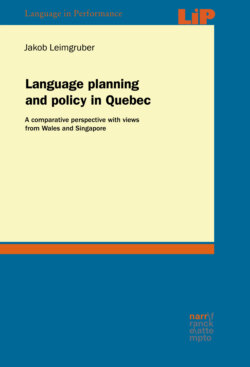Language planning and policy in Quebec

Реклама. ООО «ЛитРес», ИНН: 7719571260.
Оглавление
Jakob Leimgruber. Language planning and policy in Quebec
Inhalt
Acknowledgements
List of Figures
List of Tables
1 Introduction
1.1 The relevance of Quebec for language planning and policy research
1.2 French and English in Quebec
1.2.1 Quebec French
1.2.2 Quebec English
1.3 Aims, methods, and structure of the study
2 French and English in Canada and Quebec: historical background and language political context
2.1 Historical context
2.2 Canada: an officially bilingual country
2.2.1 Bilingualism at the federal level
2.2.2 English Canada: official monolingualism, French language provisions, allophone presence
2.2.3 Aboriginal languages and their limited role in official settings
2.3 Quebec: an officially monolingual province
2.3.1 Bill 101: the promotion of the French language
2.3.2 The effects of the Charter of the French language
2.3.3 The English language in Quebec: use, form, regulation
2.4 New Brunswick: a bilingual province
2.5 Conclusion
3 Language planning and policy: theoretical background
3.1 Theoretical approaches to language planning and policy
3.1.1 Language planning and policy models
Status planning
Corpus planning
Acquisition planning
Integrative model
3.1.2 Current trends in language planning and policy research
3.2 English language policy in multilingual settings
3.2.1 English as the world’s lingua franca
3.2.2 The role of English in multilingual polities
3.2.3 Advocacy vs. pragmatism in English language policy
3.3 Conclusion
4 Data and methodology
4.1 Data. 4.1.1 Questionnaire survey
Part 1 – About you
Part 2 – General questions
Part 3 – Questions about English
Part 4 – Questions about French
4.1.2 Linguistic landscape survey
4.1.3 Ethnographic fieldwork
4.1.4 Psycholinguistic experiments
4.2 Methodology
4.3 Research design
5 Language planning and policy in Quebec: analysis
5.1 Questionnaire survey
5.1.1 Demolinguistics and linguistic repertoires
5.1.2 Attitudinal responses
5.2 Visual language in public space: Quebec’s linguistic landscape
5.2.1 Geographical distribution of language
5.2.2 Languages, ‘marked predominance’, and linguistic creativity
5.3 Audible language: linguistic soundscape
The media soundscape
5.4 Language use in service encounters
5.5 Psycholinguistic processes
5.5.1 Semi-matched signs
5.5.2 Naturalistic signs
5.5.3 Discussion
5.6 Conclusions
6 Quebec’s LPP in a comparative perspective
6.1 The rationale for a comparative approach
6.2 Wales
6.2.1 Demolinguistics: English, Welsh, and other languages
6.2.2 The promotion of Welsh
6.2.3 Wales: inspiration for/from Quebec?
6.3 Singapore
6.3.1 Demolinguistics: four official languages, many other varieties
6.3.2 LPP in Singapore: far-reaching governmental intervention for language promotion and demotion
English language policies
‘Mother tongue’ policies
6.3.3 Singapore: Quebec’s antithesis?
6.4 Conclusion
7 Conclusion
7.1 Language policy in the era of globalisation
7.2 New ways of analysing LPP
References
Appendix. A Linguistic landscape photos
B Questionnaire
C Public transit station names and their pronunciation. C.1 Montreal métro
C.2 Suburban railway
Fußnoten. 1 Introduction
1.2.2 Quebec English
2.1 Historical context
2.2 Canada: an officially bilingual country
2.2.1 Bilingualism at the federal level
2.2.2 English Canada: official monolingualism, French language provisions, allophone presence
2.2.3 Aboriginal languages and their limited role in official settings
2.3 Quebec: an officially monolingual province
2.3.1 Bill 101: the promotion of the French language
2.3.2 The effects of the Charter of the French language
2.3.3 The English language in Quebec: use, form, regulation
3.1 Theoretical approaches to language planning and policy
Status planning
3.2.1 English as the world’s lingua franca
3.2.2 The role of English in multilingual polities
3.2.3 Advocacy vs. pragmatism in English language policy
Part 2 – General questions
4.1.2 Linguistic landscape survey
4.1.4 Psycholinguistic experiments
5.1.1 Demolinguistics and linguistic repertoires
5.1.2 Attitudinal responses
5.2 Visual language in public space: Quebec’s linguistic landscape
5.2.1 Geographical distribution of language
5.2.2 Languages, ‘marked predominance’, and linguistic creativity
5.3 Audible language: linguistic soundscape
The media soundscape
5.4 Language use in service encounters
6.1 The rationale for a comparative approach
6.2 Wales
6.2.1 Demolinguistics: English, Welsh, and other languages
6.2.2 The promotion of Welsh
6.2.3 Wales: inspiration for/from Quebec?
6.3.1 Demolinguistics: four official languages, many other varieties
English language policies
‘Mother tongue’ policies
6.3.3 Singapore: Quebec’s antithesis?
6.4 Conclusion
7.1 Language policy in the era of globalisation
Отрывок из книги
Jakob Leimgruber / Rainer Schulze
Language planning and policy in Quebec
.....
Figure 6.5: Percentage of population with knowledge of Welsh, by age group, for the past seven censuses.
Figure 6.6: Language most commonly spoken at home, as a percentage of all households. Data from 10-year census (1980–2010) and from the General Household Survey 2015. ‘Dialects’ refers to any variety of Chinese other than Mandarin.
.....